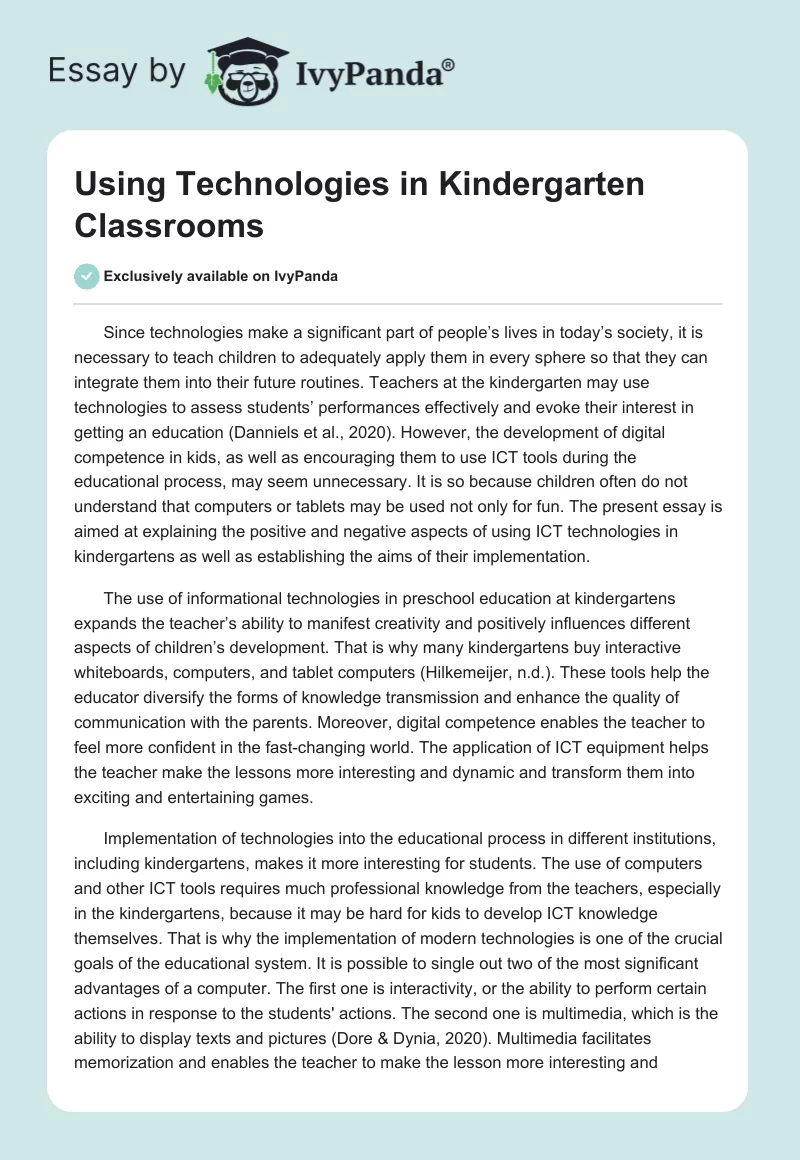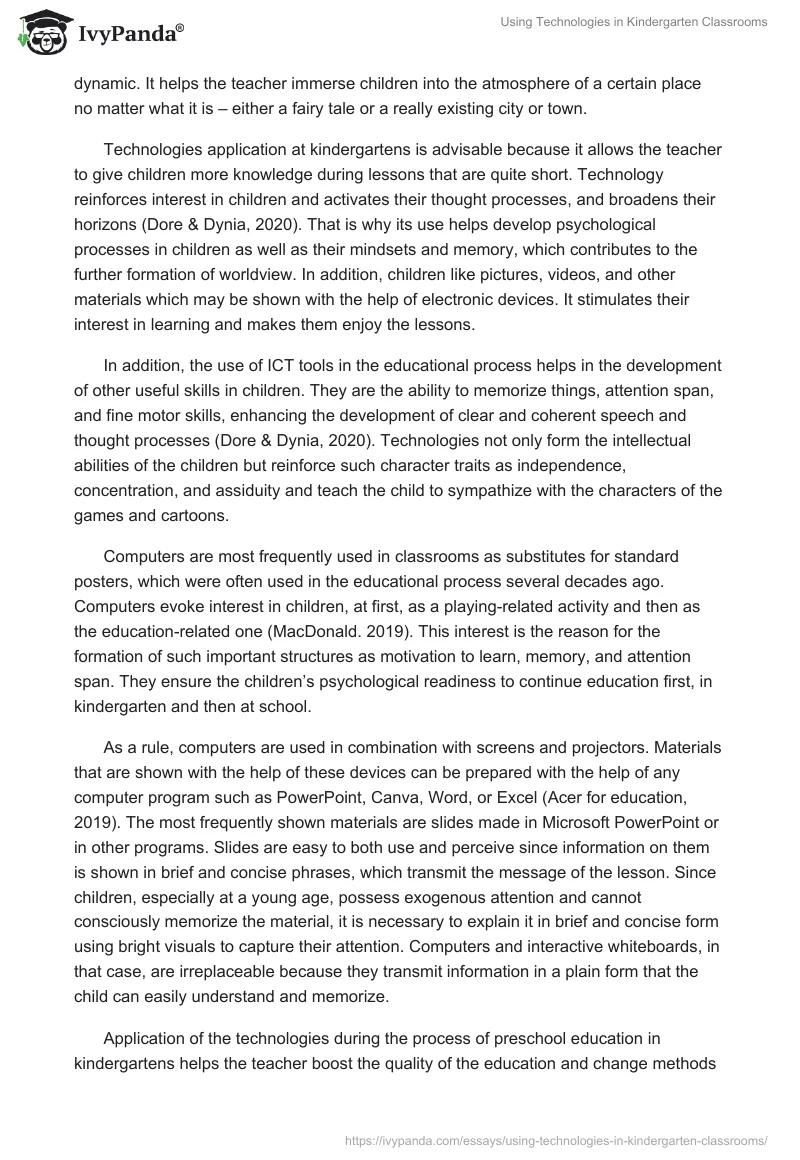Since technologies make a significant part of people’s lives in today’s society, it is necessary to teach children to adequately apply them in every sphere so that they can integrate them into their future routines. Teachers at the kindergarten may use technologies to assess students’ performances effectively and evoke their interest in getting an education (Danniels et al., 2020). However, the development of digital competence in kids, as well as encouraging them to use ICT tools during the educational process, may seem unnecessary. It is so because children often do not understand that computers or tablets may be used not only for fun. The present essay is aimed at explaining the positive and negative aspects of using ICT technologies in kindergartens as well as establishing the aims of their implementation.
The use of informational technologies in preschool education at kindergartens expands the teacher’s ability to manifest creativity and positively influences different aspects of children’s development. That is why many kindergartens buy interactive whiteboards, computers, and tablet computers (Hilkemeijer, n.d.). These tools help the educator diversify the forms of knowledge transmission and enhance the quality of communication with the parents. Moreover, digital competence enables the teacher to feel more confident in the fast-changing world. The application of ICT equipment helps the teacher make the lessons more interesting and dynamic and transform them into exciting and entertaining games.
Implementation of technologies into the educational process in different institutions, including kindergartens, makes it more interesting for students. The use of computers and other ICT tools requires much professional knowledge from the teachers, especially in the kindergartens, because it may be hard for kids to develop ICT knowledge themselves. That is why the implementation of modern technologies is one of the crucial goals of the educational system. It is possible to single out two of the most significant advantages of a computer. The first one is interactivity, or the ability to perform certain actions in response to the students’ actions. The second one is multimedia, which is the ability to display texts and pictures (Dore & Dynia, 2020). Multimedia facilitates memorization and enables the teacher to make the lesson more interesting and dynamic. It helps the teacher immerse children into the atmosphere of a certain place no matter what it is – either a fairy tale or a really existing city or town.
Technologies application at kindergartens is advisable because it allows the teacher to give children more knowledge during lessons that are quite short. Technology reinforces interest in children and activates their thought processes, and broadens their horizons (Dore & Dynia, 2020). That is why its use helps develop psychological processes in children as well as their mindsets and memory, which contributes to the further formation of worldview. In addition, children like pictures, videos, and other materials which may be shown with the help of electronic devices. It stimulates their interest in learning and makes them enjoy the lessons.
In addition, the use of ICT tools in the educational process helps in the development of other useful skills in children. They are the ability to memorize things, attention span, and fine motor skills, enhancing the development of clear and coherent speech and thought processes (Dore & Dynia, 2020). Technologies not only form the intellectual abilities of the children but reinforce such character traits as independence, concentration, and assiduity and teach the child to sympathize with the characters of the games and cartoons.
Computers are most frequently used in classrooms as substitutes for standard posters, which were often used in the educational process several decades ago. Computers evoke interest in children, at first, as a playing-related activity and then as the education-related one (MacDonald. 2019). This interest is the reason for the formation of such important structures as motivation to learn, memory, and attention span. They ensure the children’s psychological readiness to continue education first, in kindergarten and then at school.
As a rule, computers are used in combination with screens and projectors. Materials that are shown with the help of these devices can be prepared with the help of any computer program such as PowerPoint, Canva, Word, or Excel (Acer for education, 2019). The most frequently shown materials are slides made in Microsoft PowerPoint or in other programs. Slides are easy to both use and perceive since information on them is shown in brief and concise phrases, which transmit the message of the lesson. Since children, especially at a young age, possess exogenous attention and cannot consciously memorize the material, it is necessary to explain it in brief and concise form using bright visuals to capture their attention. Computers and interactive whiteboards, in that case, are irreplaceable because they transmit information in a plain form that the child can easily understand and memorize.
Application of the technologies during the process of preschool education in kindergartens helps the teacher boost the quality of the education and change methods of working with children. As was already mentioned, PowerPoint presentations help the educator give exact and brief information on a particular topic and guarantee that children understand it (MacDonald, 2019). It is so because bright and memorable pictures or figures will attract their attention, and they will not get distracted during the lesson. Technologies enable the teacher to implement games with graphic elements, images, or animation, facilitating the process of material explanation and enhancing children’s interest in education.
Cinematographic technologies are the most often used during the educational process, especially with little kids in kindergartens. It is so because they give information not in textual form that may be easily perceived by children but in figurative one. Using a representational form of explanation and material transmission is not only ergonomic but a powerful educational tool (Dore & Dynia, 2020). Implementation of videos, slides, and pictures into the lessons enables the educator to immerse children into the topic they currently study. It reinforces a more profound understanding of the subject as well as memorizing the material through imagery and emotional reaction.
In addition, technologies evoke interest in the studied topic, which contributes to better performances of the students during the lessons as well as their active engagement in the educational process. Sometimes an interesting fragment from a film or cartoon or a YouTube video makes the teacher change the structure of the lesson and bring a new topic into it (Dore & Dynia, 2020). It makes the educational material more profound, understandable, and exciting for children who, especially at a young age, are extremely active, and that is why it may be hard to capture their attention. Integrating modern technologies into the educational process in kindergartens helps educators transmit knowledge to the children and influence their emotions and perception of the materials.
Since informational technologies are the most appropriate instrument for collecting and processing informational data, educators may use them for different organizational purposes. Thus, teachers often use ICT technologies to make different lists for attendance tracking or collecting information about family situations (Dore & Dynia, 2020). In addition, ICT help in tracking children’s educational achievement, creating plans for the lessons, consulting parents on their children’s development, and giving them recommendations to follow in the future. Teachers use different computer programs and the Internet to find illustrative materials for the lessons and other out-of-class activities.
Apart from that, many kindergartens often have their own websites where it is possible to find all the necessary information about the institution, the educators who work there, and the methods of their work. Many kindergartens’ websites often have a catalog of articles on a wide range of education-related topics written by the teachers who work there (MacDonald, 2019). These articles may help educators from other institutions in their work and give the parents an opportunity to assess the educational methods used by the kindergarten and understand whether their children can attend it. Moreover, some websites often have sections for the parents’ questions where they may ask the teachers about the aspects of the educational process or the general work of the institution.
Creating a website for the kindergarten contributes to a better involvement of parents in the process of their children’s education and helps them become participants of the process but not just observers. Teachers may post information about the group activities on the kindergarten’s website or Facebook group, create short reports on the entertaining events or lessons, and post children’s photos. It will help enhance parents’ competence in education-related matters (Dore & Dynia, 2020). They will be able to see the educator’s work with the children and get acquainted with the methods they use during lessons, walks, and other out-of-class activities. In addition, communication between the parents and educators will help them establish relationships built on mutual trust, which will be beneficial for children’s development and education.
Another instance of using technologies in kindergartens concerns the constant professional development of the teachers themselves. They should be aware of all the changes in the sphere, and the best way to do it is to communicate with their colleagues in online forums or on social media (Dore & Dynia, 2020). Regular inter-professional communication enables educators to quickly find out about the changes in the field, use the methods and techniques their fellow workers do, and share their own experiences with them.
Taking into consideration everything mentioned above, it is possible to conclude that the application of informational technologies in the educational process in kindergartens is advisable since it contributes to a better understanding and more effective memorization. ICT facilitates the process of knowledge transmission from teachers to children since they enable the former to present the educational material concisely and understandably so that the kids can comprehend it. Apart from that, the use of computers and the Internet helps the teacher communicate with the parents, show them the progress their children make, and give them useful materials for work outside of kindergarten. Many educators use the Internet to find interesting materials and interactive games for their lessons, be aware of the innovations in the area and share their professional knowledge with their colleagues.
References
Acer for education (2019). The benefits of starting to use technology in kindergarten.Acer for education. Web.
Danniels, E. Pyle, A. & DeLuca, C. (2020). The role of technology in supporting classroom assessment in play-based kindergarten. Teaching and Teacher Education, 88. Web.
Dore, R. A. & Dynia, J. M. (2020). Technology and media use in preschool classrooms: Prevalence, purposes, and contexts.Frontiers in Education. Web.
Hilkemeijer, M. (n.d.). How to create an amazing tech-savvy kindergarten today. icte solutions. Web.
MacDonald, K. (2019). Meaningful use of technology in Ontario’s kindergarten classrooms. In R. Power Technology and the Curriculum. PressBooks. Web.


